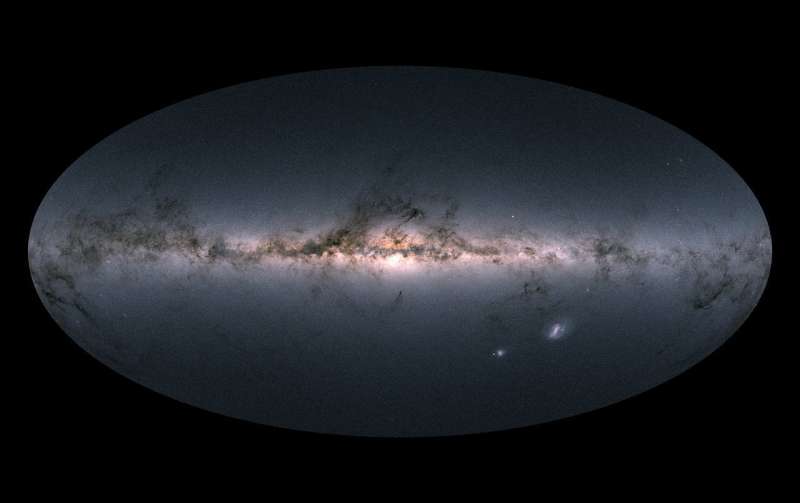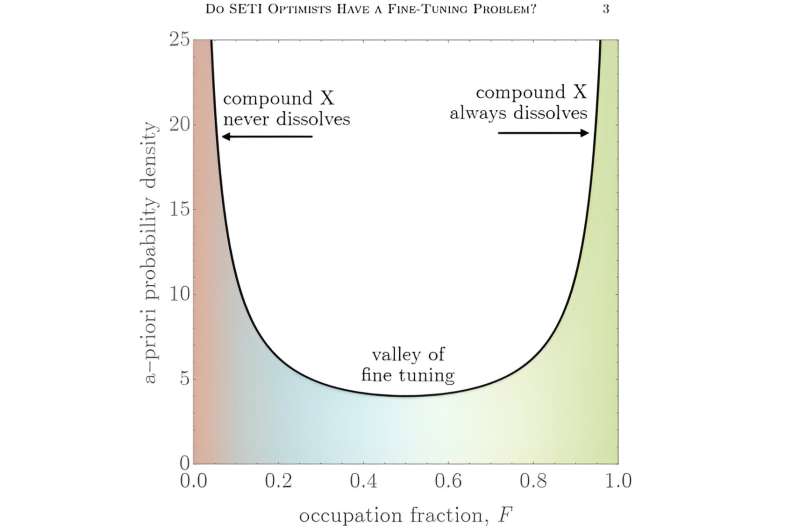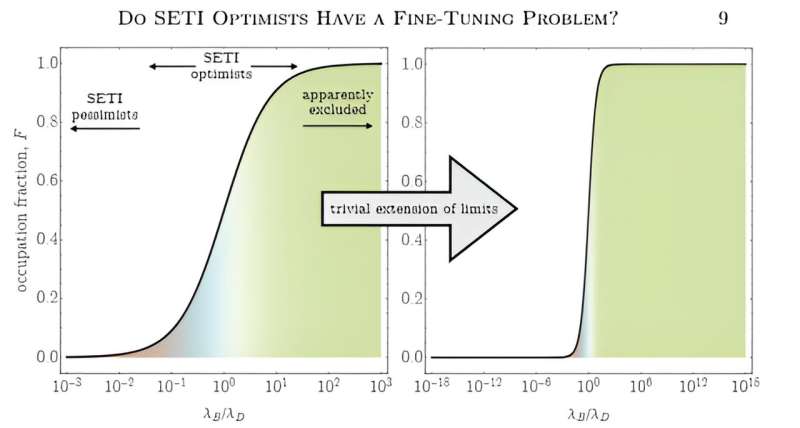This article has been reviewed according to Science X's editorial process and policies. Editors have highlighted the following attributes while ensuring the content's credibility:
fact-checked
peer-reviewed publication
trusted source
proofread
New study suggests that our galaxy is crowded or empty—both are equally terrifying

Is there intelligent life in the universe? And if so, just how common is it? Or perhaps the question should be, what are the odds that those engaged in the Search for Extraterrestrial Intelligence (SETI) will encounter it someday?
For decades, scientists have hotly debated this question, and no shortage of ink has been spilled on the subject. From the many papers and studies that have been written on the topic, two main camps have emerged: those who believe life is common in our galaxy (aka SETI Optimists) and those who maintain that extraterrestrial intelligence is either rare or non-existent (SETI Pessimists).
In a recent paper, David Kipping (Prof. "Cool Worlds" himself) and Geraint Lewis examined this debate more closely and offered a fresh take based on a form of probability analysis known as Jayne's Experiment.
By applying this method to astrobiology and the Drake Equation, they concluded that the existence of intelligent life in our galaxy may be an "all or nothing" proposition. To quote the late and great scientist and science fiction author Arthur C. Clarke: "Two possibilities exist: either we are alone in the universe, or we are not. Both are equally terrifying."
Kipping is an Associate Professor of Astronomy at Columbia University and a Carl Sagan Fellow at the Harvard College Observatory. He is also the Principle Investigator of the Cool Worlds Lab at Columbia, which is dedicated to studying and characterizing exoplanet systems. Geraint Lewis is a Professor of Astrophysics at the Sydney Institute for Astronomy, part of the university of Sydney's School of Physics.
Their paper, "Do SETI Optimists Have a Fine-Tuning Problem?" was recently posted to the arXiv preprint server and is being reviewed for publication in the International Journal of Astrobiology.
The Drake Equation
In 1961, famed astronomer Frank Drake hosted the first SETI meeting ever at the Greenbank Observatory in West Virginia. In preparation for the event, he created an equation summarizing the challenges SETI researchers faced. This came to be known as the Drake Equation and is expressed mathematically as:
N = R* × fp × ne × fl × fi × fc × L
Where:
- N is the number of currently active, communicative civilizations in our galaxy.
- R* is the rate at which stars form in our galaxy.
- fp is the fraction of stars with planets.
- ne is the number of planets that can potentially host life, per star that has planets.
- fl is the fraction of the above that actually do develop life of any kind.
- fi is the fraction of the above that develop intelligent life.
- fc is the fraction of the above that develop the capacity for interstellar communication.
- L is the length of time that such communicative civilizations are active.
The Drake Equation was not intended to estimate the number of extraterrestrial civilizations (ETCs) in our galaxy but to stimulate dialogue about SETI. Since Drake first formulated it, the equation has been subject to criticism, additions, and revisions and has often been misrepresented in the process. As Prof. Kipping explained to Universe Today via email, part of the problem is how values are often arbitrarily applied to the parameters:
"Since we don't know most of the parameters, this is just pure speculation, and it should be labeled as such. Another point often missed is that it represents the mean number of civilizations and, thus, an expectation value of some underlying distribution.
"These days, it's become a bit of a sport to critique the Drake equation. Certainly, anyone using it as a calculator should be fairly criticized, but the basic idea is not wrong. There must be some number of civilizations out there, and we could, in principle, collect relevant parameters to calculate it. The issues arise in the exact formulation, which parameters to include, what they really mean, and how to deal with nuances like time variability."
Jayne's Experiment
Edwin Jaynes (1922–1998) was the Wayman Crow Distinguished Professor of Physics at Washington University in St. Louis. In 1968, he imagined an experiment where a person in a lab is presented with a jar containing an unknown and unlabeled compound (chemical X).
Along a laboratory bench, there are a large number of beakers filled with water, and the experiment is to test how often chemical X will dissolve within them. Jaynes argued that one should expect the compound to either dissolve in nearly every instance or almost never.

When plotted on a graph, the probability distribution would be bowl-shaped, with values peeking at 0 and 1. As Kipping explained in more detail:
"Jaynes imagined a series of what we call Bernoulli experiments—that is, experiments that return yes/no answers. These could be anything really, but as an example, he imagined dissolving an unknown chemical into a series of beakers containing water and then asking—what fraction of them will dissolve?
"Another scientist, the legendary John Haldane, had already suggested that an answer of ~50% was unlikely a-priori. One should expect that either nearly all of them will dissolve or hardly any.
"Jaynes rigorously proved that and pioneered many of the tools of objective Bayesian inference. We can equally replace the Bernoulli experiment under consideration with other questions, like what fraction of stars will become a black hole?
"Before obtaining any observations, an answer of ~50% would be surprising, implying that the distribution of stellar masses is finely balanced such that half are above the critical mass threshold and half below. In reality the answer is one-in-a-thousand, which falls in line with Jayne's position."
Because of his immense contributions to the field of statistics, Jaynes is credited with being one of the founders of "Objective Bayesianism." While his experiment was not intended as such, Kipping and Lewis saw its potential application in astrobiology.
All or nothing?
In his seminal 1983 paper, "The Great Silence—the Controversy Concerning Extraterrestrial Intelligent Life," David Brin addressed the ongoing debate regarding the existence of extraterrestrial life. From this, he discerned the presence of two camps when it came to the debate: "Contact Optimists" and "Contact Pessimists"—or as Kipping and Lewis refer to them in their paper, "SETI Optimists" and "SETI Pessimists"—those who believe that there are civilizations in our galaxy humanity can make contact with and those who believe it is fruitless since humanity is alone in the universe.
When Jaynes' Experiment is applied to the question of intelligent life in our galaxy, we should expect that it would either be very common or very rare. In the middle, where the probability distribution is weakest (i.e., extraterrestrial life is semi-common), is where the "fine-tuning problem" emerges. In the context of cosmology and astrobiology, fine-tuning refers to the proposition that the conditions for life can occur only when certain universal constants lie within a very narrow range of values.
If any of these fundamental constants were slightly different, the universe would not be conducive to the development of matter, large-scale structures, or life as we know it. As Kipping explained, this presents a problem for SETI Optimists:
"Unlike the black hole example I gave you earlier, there's no lower bounds on this problem. With black holes, we know the smallest and biggest allowed star mass from astrophysics and it's only a few orders of magnitude. The black hole threshold must be in that fairly narrow range somewhere. When it comes to aliens, the probability of intelligence could be 1% or 0.000….00001% (add as many zero's as you like).
"With a such a vast range of possibilities, SETI optimists have to believe the rather contrived view that the % value is not so high that we wouldn't see anyone yet, but certainly far higher than the deep abyss of low probabilities that are plausible. Thus they have a fine-tuning problem essentially, needing the percentage to live in a fairly narrow corridor."
If our galaxy were filled with extraterrestrial civilizations, surely there would be undeniable signs that we would have noticed—i.e., radio signals, megastructures, Clarke Bands, and other "technosignatures." If this is starting to sound familiar, it's because this argument is the very core of the Fermi Paradox (which we have written an entire series about!) As such, one could construe Kipping and Lewis' argument as an example of SETI Pessimism. Luckily, the story does not end there.
A new formalism
Faced with this result, Kipping and Lewis attempted to devise a new formalism for the Drake Equation that considers just two processes: the birth rate and the death rate of civilizations. When this is done, all of the parameters in the equation (except for L, the lifespan of civilizations) collapse into a single parameter: the birth and death rate of civilizations (rc). Or as it would appear mathematically: NC = rc x LC. Said Kipping:
"In the standard Drake equation, we often get caught up arguing about which parameters to include (should there be a fraction for the probability of life developing into multicellular life, for example). But it's completely undeniable that every civilization must have a beginning and an end, in fact we can even set the death rate to zero, which corresponds to infinite lifetimes if we so desire in this framework.
"In an ecological system, like a petri dish, for example, there is a well-defined maximum possible population that we call the carrying capacity. So, we updated the birth-death version of the Drake equation to account for this nuance."

In this case, the distribution of probabilities became S-shaped (see image above), but the end result was still the same: either the galaxy is crowded or empty. One way around this is the idea that humanity could be alive during a period in which ETCs have emerged and are beginning to expand throughout the galaxy and thus have not been noticed by our instruments yet. However, as Kipping and Lewis showed, this also suffers from the fine-tuning problem, as biology indicates that population growth is an accelerating phenomenon.
"You see, galactic expansion phases should be relatively quick on a cosmic timescale; in fact, really like the blink of an eye," said Kipping. "So it's unlikely you'd live during such a phase; you're more likely to live when the galaxy is essentially empty before this happens or after it's happened (which, in fact, is arguably impossible since your planet is colonized). Once again, Fermi's Paradox rears its head, where the strongest likelihood is that humanity is either alone, early to the party, or one of a few civilizations currently existing in the Milky Way.
Hope for SETI?
But before you go thinking it's all bad news, Kipping and Lewis emphasize that SETI is an important and vital experiment that deserves dedicated resources. "While the odds of success appear small, such a success would arguably represent the most impactful scientific discovery in human history," they conclude. They also suggest several reasons to remain hopeful, which include Hanson's "Grabby Aliens" hypothesis, which states that humanity is at the midpoint in the S-shaped curve and that we will encounter an ETI in a few hundred million years.
In the meantime, Kipping also suggests that SETI could benefit from casting a wider net. If, as their study suggests, advanced civilizations are very rare (or non-existent) in our galaxy, then we should look to extra-galactic sources.
"I think my favorite way out is that our galaxy is just unusually quiet, most are busy and filled, but we are the first in the Milky Way," he added. "This seems improbable, but perhaps being born in a busy galaxy is impossible since the habitable real estate has already been gobbled up. This suggests we should put more emphasis on extra-galactic SETI as our best shot."
More information: David Kipping et al, Do SETI Optimists Have a Fine-Tuning Problem?, arXiv (2024). DOI: 10.48550/arxiv.2407.07097
Journal information: International Journal of Astrobiology , arXiv
Provided by Universe Today





















